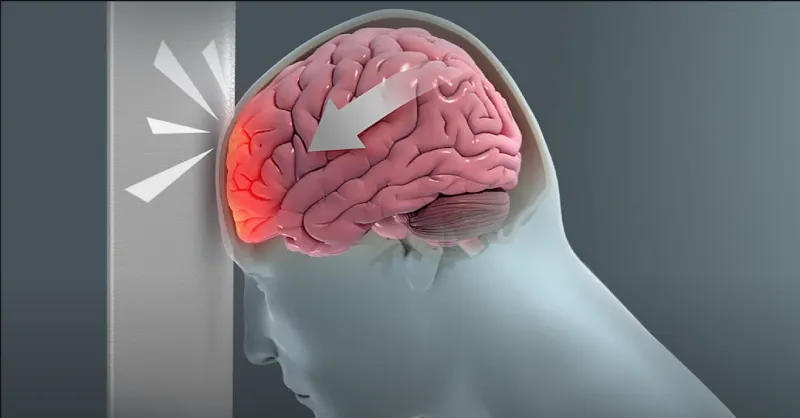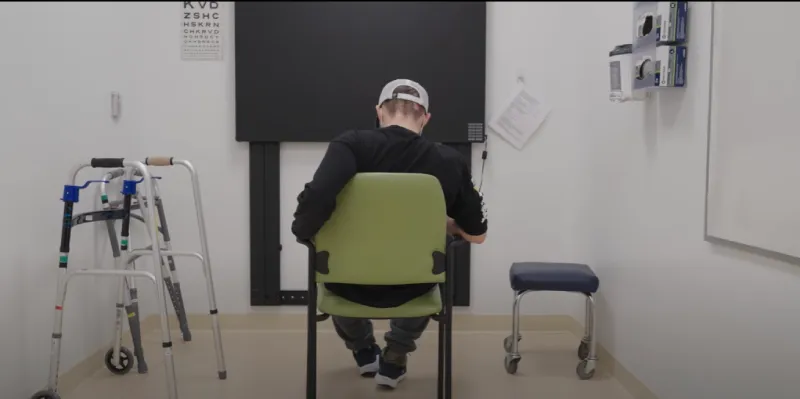Traumatic injuries stem from various causes, such as blunt force, sharp objects, and burns. They encompass motor accidents, sports mishaps, falls, natural calamities, and a range of physical harm incidents at home, on the road, or at work, causing prompt attention.
A traumatic head injury for a cyclist can occur without a direct blow to the head. When a motor vehicle hits the rider or their bike, the impact can force the brain to collide with the skull’s hard interior, leading to brain damage. This type of injury is known as a traumatic brain injury (TBI) and can have severe consequences for cyclists.
This blog post will address the significant threat of TBIs among cyclists, exploring causes, symptoms, and impacts and offering guidance on prevention, treatments, and safety advancements.
What Is Traumatic Head Injury For Cyclist: 5 Factors

Cycling brings joy and fitness perks, yet it also poses the threat of Traumatic Brain Injury (TBI). This article delves into the crucial aspect of managing TBIs in cycling, covering causes, treatment, and preventive measures to uphold rider safety.
Section 1: Incidence of TBI in Cycling
Cycling, a sport beloved by many for its health benefits and environmental friendliness, unfortunately, carries a significant risk of Traumatic Brain Injury (TBI). This section explores the surprisingly high incidence of TBIs among cyclists and compares it to other popular sports.
A Closer Look at Cycling-Related TBIs
Taking up cycling isn’t just a leisure activity or exercise for many; it’s a way of life. However, it’s important to recognize the risks involved, especially concerning head injuries. Studies have shown that cycling leads to the highest number of sports and recreation-related emergency department visits for TBIs. This underscores the need for increased safety precautions and awareness within the cycling community.
- Emergency Department Visits: Cyclists make up a significant portion of patients admitted to emergency departments with TBIs, more so than participants of any other sport.
- Risks on the Road: most of these injuries occur because of collisions with vehicles or falls from the bike, highlighting the inherent dangers of cycling, especially in urban areas.
Comparing TBIs Across Different Sports
When we compare cycling with other sports, the contrast is stark. While football, basketball, soccer, and hockey are often cited for their physicality and associated injury risks, cycling surpasses them all in terms of TBI occurrences.
- Cycling vs. Football: Although football is well-known for its concussion controversies, cyclists face a greater risk of TBIs, many of which lead to emergency room visits.
- Basketball, Soccer, and Hockey: These sports, while involving physical contact and potential for head injuries, have lower incidences of TBIs compared to cycling.
This comparison doesn’t aim to downplay safety in other sports but to emphasize cycling’s unique risks. It urges all in the cycling community, from casual riders to pros, to prioritize helmet use and embrace safer cycling practices.
Section 2: Causes of TBI in Cyclists

A good understanding of Traumatic Brain Injuries (TBIs) in cyclists is essential for preventing and treating them. This section examines the scenarios that frequently lead to head injuries in cycling, emphasizing the importance of recognizing early warning signs such as helmet damage and loss of consciousness.
Frequent Causes of Cycling-Related TBIs
Cyclists face various hazards on the road and trails, but certain situations are more likely to result in TBIs:
- Collisions with Vehicles: A significant number of cycling TBIs occur due to impacts on cars, trucks, and other vehicles. These accidents often result from visibility issues, distracted driving, or misunderstanding of cyclists’ rights on the road.
- Falls from the Bike: Slips, trips, and technical errors can lead to falls, which are another common cause of head injuries. Factors include slippery road surfaces, sudden stops, and inexperienced handling.
Helmet Damage as an Early Warning Sign
The condition of a cyclist’s helmet post-accident provides important information about potential head injury:
- Cracks and Dents: Visible damage to the helmet indicates it absorbed a significant impact, which might have otherwise been directed to the cyclist’s head.
- Strap and Fit Issues: A helmet that came off during an accident or was improperly fitted at the time of impact suggests a higher risk of head injury because of inadequate protection.
The Significance of Loss of Consciousness
Experiencing loss of consciousness, even briefly, after a cycling accident, is a powerful indicator of a TBI:
- Immediate Attention Required: Any loss of consciousness, no matter how brief, causes immediate medical evaluation to assess the potential for a TBI.
- Delayed Symptoms: Cyclists who lose consciousness may not exhibit other symptoms immediately but could still have sustained a brain injury. Monitoring and medical assessment are critical.
Section 3: Symptoms and Diagnosis of Cyclist TBIs
Traumatic Brain Injuries (TBIs), particularly concussions, represent a significant risk to cyclists. Understanding the symptoms of a concussion and the importance of accurately reporting these symptoms following a cycling accident is crucial for timely diagnosis and treatment. This section provides a comprehensive overview of concussion symptoms and underscores the significance of awareness and reporting in cycling accidents.
Recognizing Concussion Symptoms
Concussions, a common form of TBI among cyclists, result in a wide range of symptoms, which may vary in intensity and duration. Identifying these symptoms early is key to preventing further injury and facilitating recovery:
- Physical Symptoms: These can include headache, dizziness, nausea, low blood pressure, and difficulty with balance.
- Cognitive Impairments: Difficulty concentrating, memory problems, and confusion are common cognitive signs of a concussion.
- Emotional Changes: Cyclists experiencing a concussion might also exhibit changes in mood, such as irritability, depression, or anxiety.
- Sleep Disturbances: Altered sleep patterns, including difficulty falling asleep or sleeping more than usual.
The Importance of Reporting Symptoms
After a cycling accident, it’s essential for individuals to report any concussion-like symptoms they’re experiencing, regardless of how minor these may seem:
- Immediate Reporting: Sharing symptoms with healthcare providers as soon as possible can improve the outcomes of TBIs. It allows for early intervention and prevents the exacerbation of the injury.
- Continued Monitoring: Symptoms of a concussion may not appear immediately after an accident. Continuous monitoring and reporting of any new or worsening symptoms are critical.
Diagnosis and Assessment
Upon reporting symptoms, healthcare professionals will conduct a series of assessments to diagnose a concussion:
- Neurological Examination: Tests that evaluate balance, coordination, and reflexes to assess the brain’s functioning.
- Cognitive Tests: Assessments focusing on memory, concentration, and the ability to recall information.
- Imaging Tests: While not always necessary, CT scans or MRIs may examine the brain for more severe injuries.
Early recognition of concussion symptoms, coupled with prompt and precise reporting, can greatly impact the diagnosis, treatment, and recovery of cyclists with TBIs. Raising awareness of these symptoms and urging swift action can boost cycling community safety and well-being.
Section 4: Treatment and Recovery from TBIs

During a cycling accident involving a Traumatic Brain Injury (TBI), the steps taken immediately after the incident, along with the subsequent treatment and recovery process, are crucial to the outcome. This section summarizes the immediate actions following a head injury and offers insights into the long-term recovery trajectory for cyclists who have experienced a TBI.
Immediate Steps Following a Head Injury
The moments following a head injury are critical. Prompt action can significantly influence the recovery process:
- Ensure Safety: Move the injured person to a safe location if it’s safe to do so. Avoid moving them unnecessarily if you suspect spine injuries.
- Seek Medical Attention Immediately: Any head injury should be treated as serious. Call emergency services or get to a hospital as soon as possible, even if symptoms seem mild.
- Monitor Symptoms: Keep a close eye on the individual for any changes in consciousness, confusion, difficulty speaking, or worsening symptoms, and report to medical personnel.
Medical Treatment
The initial medical response may include various diagnostic tests and assessments:
- Imaging Tests: CT scans or MRIs are commonly used to assess the extent of the brain injury.
- Observation: In cases of mild concussions, observation for a period to monitor symptoms may be recommended.
- Medications: Some medications are prescribed to manage pain, prevent seizures, or address other specific concerns, depending on your condition.
Rehabilitation Process
Recovery from a TBI can vary greatly among individuals, often involving a multi-disciplinary approach:
- Physical Therapy: To regain strength, balance, and coordination.
- Occupational Therapy: To help return to daily activities and work, adapting techniques as needed.
- Speech-Language Therapy: Especially if communication has been affected.
- Neuropsychological Support: To address cognitive changes and emotional support during recovery.
Returning to Cycling
The return to cycling should be gradual and carefully managed:
- Medical Clearance: Before returning to cycling or any physical activity, getting clearance from a healthcare provider is essential.
- Start Slow: Begin with light, low-impact activities before accumulating intensity.
- Listen to Your Body: Pay attention to how your body responds to increased activity and consult with healthcare providers if symptoms reappear or worsen.
Long-Term Considerations
Long-term recovery can involve ongoing management of symptoms and adaptations to lifestyle:
- Regular Medical Follow-ups:Continued assessment by healthcare providers to monitor recovery progress.
- Adjustments in Activities: changing cycling habits and avoiding high-risk situations to prevent potential reinjuries.
- Support Systems: Leveraging support from family, friends, and support groups for emotional and practical help during the recovery phase.
Section 5: Prevention and Safety Measures

Preventing Traumatic Brain Injuries (TBIs) among cyclists involves a multifaceted approach that emphasizes using safety gear, adherence to traffic laws, and adopting best practices while cycling. This section highlights the helmet’s crucial role in reducing the risk of head injuries and offers comprehensive recommendations for cyclists aiming to enhance their safety on the road.
The Critical Role of Helmets
The difference in injury prevalence between helmeted and non-helmeted cyclists is stark and underscores the importance of helmet usage:
- Injury Reduction: Research consistently demonstrates that helmets can decrease the likelihood of head injuries by as much as 85%. Cyclists who wear helmets have a substantially lower risk of experiencing traumatic brain injuries (TBIs) after an accident.
- Helmet Standards: Not all helmets are created equal. Cyclists should look for helmets that meet the standards of consumer product safety organizations (CPSC).
Safety Gear Beyond Helmets
While helmets are essential, other pieces of safety gear can also contribute to a cyclist’s overall protection:
- Lights and Reflective Gear: Enhancing visibility, especially during dawn, dusk, or nighttime, is crucial. Front and rear lights, reflective clothing, and bike reflectors can increase cyclists’ visibility.
- Protective Clothing: Wearing gloves can protect hands in a fall, and padded cycling shorts can provide extra protection during longer rides.
Adhering to Traffic Laws
Obeying traffic regulations is not just a legal requirement but also a vital safety practice:
- Ride with traffic: Always ride in the traffic direction, using bike lanes where available.
- Signal Turns and Stops: Using hand signals communicates intentions to drivers and other cyclists, reducing the risk of collisions.
- Stop at Stop Signs and Lights: Cyclists must adhere to the same stop signs and traffic lights as motorists, ensuring safe crossings and turns.
Cycling Best Practices
Incorporating best practices into daily cycling routines can further decrease the risk of accidents and injuries:
- Stay Alert: Monitor your surroundings, including vehicles, pedestrians, and potential road hazards.
- Maintain Your Bike: Regular maintenance checks (tires, brakes, gears) ensure that your bike operates correctly so mechanical problems are minimized.
- Use Bike Paths When Available: Preferentially use dedicated bike paths or lanes designed for safer cycling away from vehicular traffic.
Conclusion
Cyclists’ journeys come with risks. Our discussion on Traumatic Brain Injuries (TBIs) highlights their seriousness, common causes, and key symptoms.
But it’s not all bleak -we can significantly reduce these risks together. We ensure safer rides by donning helmets, obeying traffic laws, and embracing cycling best practices.
Awareness, prevention, and proper treatment are vital in safeguarding our vibrant cycling community. Keep pedaling, stay safe, and let’s pave the way to a safer future for cyclists!
FAQs
What Are The Common Types of Head Injury in Cyclists?
Subarachnoid hemorrhage and skull fractures emerged as prevalent head injuries among cyclists. Further analysis of cyclist collision scenarios can be conducted through a biomechanical lens.

